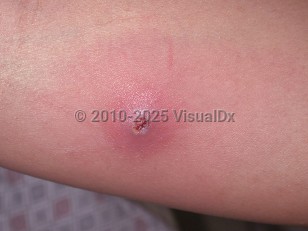CA-MRSA skin infection in Infant/Neonate
Alerts and Notices
Important News & Links
Synopsis

Skin and soft tissue infections (SSTIs) including cellulitis, abscesses, impetigo (bullous and nonbullous), folliculitis, and furunculosis can all be caused by infection with Staphylococcus aureus, including methicillin-resistant S aureus, or MRSA.
MRSA was first identified in 1961, shortly after the introduction of methicillin. Since that time, MRSA has widely been recognized as an important agent of disease in hospitals, nursing homes, and other long-term care facilities. Beginning in the 1990s, however, outbreaks of MRSA were recognized among healthy children, athletes, prisoners, military recruits, and intravenous drug users in the community at large. Most of those with MRSA infections lacked "traditional" MRSA risk factors, such as exposure to the health care system.
MRSA is no longer primarily limited to hospital-acquired infection. Over the past 2 decades, the incidence of community-associated MRSA (CA-MRSA) has been increasing. In many parts of the United States, over 50% of community-associated S aureus isolates are MRSA. Hence, infections where S aureus is suspected should be considered MRSA unless susceptibility studies demonstrate otherwise.
The most common manifestation of CA-MRSA infections are skin and subcutaneous infections. Many infections are attributed by patients to spider bites, although an exposure to a spider is typically not recalled by patients. They may occur in tattoos. MRSA skin infections occur in patients of all ages and among people with no traditional risk factors, or even recently described risk factors. Clearly, any person, regardless of background or exposures, can acquire a CA-MRSA infection.
Virtually all CA-MRSA isolates retain susceptibility to vancomycin, linezolid, daptomycin, and trimethoprim-sulfamethoxazole (TMP-SMX). Most isolates are susceptible to clindamycin and tetracyclines, although susceptibility can vary by geography. While CA-MRSA has a propensity for causing skin and soft tissue infections, it can also cause more severe and invasive disease syndromes including necrotizing pneumonia, empyema, necrotizing fasciitis, pyomyositis, septic thrombophlebitis with pulmonary embolization, osteomyelitis, and severe sepsis syndrome, among other manifestations. "Spider bite"-like skin infections and the more severe syndromes may be due in large part to a specific exotoxin present in many strains of CA-MRSA, Panton-Valentine leukocidin (PVL). PVL, a virulence factor that is lethal to neutrophils, has also been implicated in cases of invasive CA-MRSA infections such as necrotizing pneumonia.
Livestock-Associated MRSA (LA-MRSA)
Staphylococcus aureus may colonize or cause disease in animals (pigs, cattle, poultry, etc). The transmission of strains associated with animal infections resulting in colonization and/or disease in humans has been described in people in close contact (veterinarians, livestock fair attendees, etc) with a variety of species that harbor S aureus. Animals may also act as reservoirs of S aureus strains such as USA300, typical CA-MRSA in humans.
MRSA was first identified in 1961, shortly after the introduction of methicillin. Since that time, MRSA has widely been recognized as an important agent of disease in hospitals, nursing homes, and other long-term care facilities. Beginning in the 1990s, however, outbreaks of MRSA were recognized among healthy children, athletes, prisoners, military recruits, and intravenous drug users in the community at large. Most of those with MRSA infections lacked "traditional" MRSA risk factors, such as exposure to the health care system.
MRSA is no longer primarily limited to hospital-acquired infection. Over the past 2 decades, the incidence of community-associated MRSA (CA-MRSA) has been increasing. In many parts of the United States, over 50% of community-associated S aureus isolates are MRSA. Hence, infections where S aureus is suspected should be considered MRSA unless susceptibility studies demonstrate otherwise.
The most common manifestation of CA-MRSA infections are skin and subcutaneous infections. Many infections are attributed by patients to spider bites, although an exposure to a spider is typically not recalled by patients. They may occur in tattoos. MRSA skin infections occur in patients of all ages and among people with no traditional risk factors, or even recently described risk factors. Clearly, any person, regardless of background or exposures, can acquire a CA-MRSA infection.
Virtually all CA-MRSA isolates retain susceptibility to vancomycin, linezolid, daptomycin, and trimethoprim-sulfamethoxazole (TMP-SMX). Most isolates are susceptible to clindamycin and tetracyclines, although susceptibility can vary by geography. While CA-MRSA has a propensity for causing skin and soft tissue infections, it can also cause more severe and invasive disease syndromes including necrotizing pneumonia, empyema, necrotizing fasciitis, pyomyositis, septic thrombophlebitis with pulmonary embolization, osteomyelitis, and severe sepsis syndrome, among other manifestations. "Spider bite"-like skin infections and the more severe syndromes may be due in large part to a specific exotoxin present in many strains of CA-MRSA, Panton-Valentine leukocidin (PVL). PVL, a virulence factor that is lethal to neutrophils, has also been implicated in cases of invasive CA-MRSA infections such as necrotizing pneumonia.
Livestock-Associated MRSA (LA-MRSA)
Staphylococcus aureus may colonize or cause disease in animals (pigs, cattle, poultry, etc). The transmission of strains associated with animal infections resulting in colonization and/or disease in humans has been described in people in close contact (veterinarians, livestock fair attendees, etc) with a variety of species that harbor S aureus. Animals may also act as reservoirs of S aureus strains such as USA300, typical CA-MRSA in humans.
Codes
ICD10CM:
A49.02 – Methicillin resistant Staphylococcus aureus infection, unspecified site
SNOMEDCT:
423561003 – Community-acquired methicillin-resistant Staphylococcus aureus infection
A49.02 – Methicillin resistant Staphylococcus aureus infection, unspecified site
SNOMEDCT:
423561003 – Community-acquired methicillin-resistant Staphylococcus aureus infection
Look For
Subscription Required
Diagnostic Pearls
Subscription Required
Differential Diagnosis & Pitfalls

To perform a comparison, select diagnoses from the classic differential
Subscription Required
Best Tests
Subscription Required
Management Pearls
Subscription Required
Therapy
Subscription Required
References
Subscription Required
Last Updated:12/07/2021
CA-MRSA skin infection in Infant/Neonate

